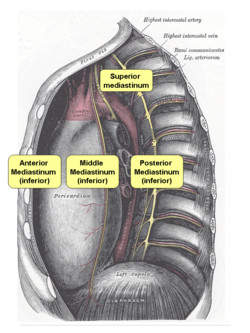|
UPDATED: The mediastinum is the median region of the thorax, usually described as the "space"1 between the lungs. This region is divided into a superior and inferior mediastinum by a plane that pases through the sternal angle or Angle of Louis. The inferior mediastinum is itself divided into three separate regions by the pericardial sac. The region anterior to the pericardial sac is the "anterior mediastinum", the region posterior to the pericardial sac is the "posterior mediastinum", and the region containing and including the pericardial sac is the "middle mediastinum". Thus described the mediastinum comprises four regions as follows: • Superior mediastinum: It contains the aortic arch, the brachiocephalic trunk, the thoracic segments of the left common carotid and the left subclavian arteries, the brachiocephalic veins, a portion of the superior vena cava, the vagus nerve, phrenic nerve, and left recurrent laryngeal nerve, trachea, esophagus, thoracic duct and the remains of the thymus gland • Anterior mediastinum: A narrow space, more developed on the left side, anterior to the pericardial sac and contains some lymph nodes and connective tissue • Middle mediastinum: The largest mediastinal region, it contains the pericardial sac, the heart, the bifurcation of the trachea, the inferior vena cava, and the cardiac end of the great vessels |

Images courtesy of Wikipedia.org |
| • Posterior mediastinum: Contains the descending aorta, the azygos and hemiazygos veins, the esophagus, and thoracic duct. 1. Personally, I do not use the description of the mediastinum as a "the space beween the lungs", as it conjures the image of literal "open spaces" around or between the organs. The fact is that the mediastinum is tightly packed with no spaces between the organs. This is why I prefer the definition of the mediastinum as an "area" or "region" between the lungs. Dr. Miranda. |
|
| MTD Main Page | Subscribe to MTD |